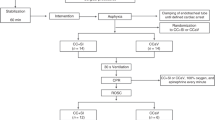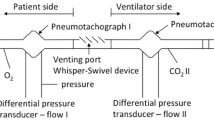Abstract
ABSTRACT: In 20 piglets aged 2–12 d (mean 6.8 d) and anesthetized with α-chloralose-urethane, we investigated the contribution of the peripheral and central chemoreceptors to the ventilatory response to inhalation of CO2 in air. For this purpose we used the dynamic end-tidal forcing technique, applying square-wave changes in end-tidal CO2 tension of 1.5–2.0 kPa at a constant end-tidal O2 tension of 15 kPa. Each response, measured on a breath-to-breath basis, was separated into a fast peripheral and a slow central component by fitting the sum of two exponentials to the measured ventilation. Each component was characterized by a CO2 sensitivity, a time constant, a time delay, and an apneic threshold. The results showed that in 2− to 12-d-old piglets the peripheral chemoreceptors are responsive to CO2 during air breathing. The contribution of the peripheral chemoreceptors in mediating the response to CO2 averaged 30 ± 10%. Within this age range we could not demonstrate a significant correlation of the parameters characterizing the dynamic ventilatory response to CO2 with postnatal age.
Similar content being viewed by others
Log in or create a free account to read this content
Gain free access to this article, as well as selected content from this journal and more on nature.com
or
Author information
Authors and Affiliations
Rights and permissions
About this article
Cite this article
Wolsink, J., Berkenbosch, A., DeGoede, J. et al. Ventilatory Sensitivities of Peripheral and Central Chemoreceptors of Young Piglets to Inhalation of CO2 in Air. Pediatr Res 30, 491–495 (1991). https://doi.org/10.1203/00006450-199111000-00018
Received:
Accepted:
Issue date:
DOI: https://doi.org/10.1203/00006450-199111000-00018



